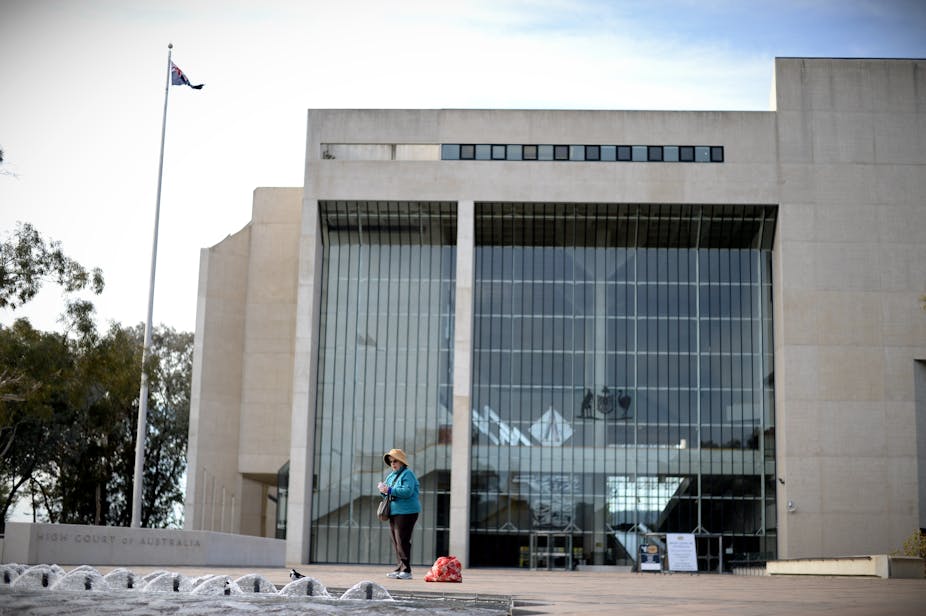The full bench of the High Court will hear the case of 157 Sri Lankan asylum seekers currently on an Australian customs vessel over two days, starting on August 5.
But when the High Court issued an injunction to prevent the attempted return of the asylum seekers to Sri Lankan authorities earlier in July, it placed itself in a significant power struggle with the executive government. The High Court exercised judicial power to curb – temporarily, until a full hearing – the exercise of executive power.
Even though this exercise of judicial power is lawful and perfectly in line with the separation of powers doctrine, in pursuing the proper application of relevant law, the judiciary emerges as a political and activist institution, frustrating the militarised strategies of the Abbott government in asylum policy.
The international law principle of non-refoulement is at the heart of discussions about whether the government’s initiatives are lawful. As Maria O’Sullivan noted:
This principle is the most fundamental provision in the UN Convention.
It is absolutely critical to the rationale and operations of international refugee and human rights law that asylum seekers are not sent back to places from which they have fled because of the fear of persecution. Without this fundamental provision being advanced by signatories to human rights conventions, protection for asylum seekers becomes meaningless.
Non-refoulement played a critical but perhaps under-discussed role during the Tampa crisis in 2001. At that time, the Howard government prevented 438 asylum seekers from landing on Australian soil, keeping them in limbo on the high seas. In response, the government introduced the “Pacific Solution” of offshore processing of refugee claims in countries such as Nauru and Papua New Guinea.
While the Pacific Solution was critiqued extensively for disallowing the processing of asylum seekers on Australian soil, it still operated within the rationale of non-refoulement. Asylum seekers would not be sent back to the places of danger from which they fled, but would instead be sent to third-party countries.
In the current case, the Tamil asylum seekers have been transferred to a customs vessel and are, like the Tampa refugees in 2001, in legal limbo while on the high seas.
In 2001, the Howard government was assisted in asserting its sovereign will to exclude asylum seekers by the Federal Court finding in its favour. It found that the Migration Act could be bypassed because the constitutional “executive power” trumped it.
In this high seas drama, Ron Merkel QC, on behalf of the asylum seekers, is arguing that the Migration Act should apply to prevent the return of the Sri Lankan asylum seekers. In contrast, Solicitor-General Justin Gleeson for the government argues that:
… none of the persons Mr Merkel represents were in Australia so as to trigger any rights.
The government’s argument is that since the boat:
… did not enter Australian waters or reach the Australian migration zone, any claims made under the Migration Act are inapplicable.
The maritime nature of these events is significant. That people cannot reach Australian territorial waters prevents them from having the benefit of domestic laws applied to their situation. But it is not accidental that they cannot reach the waters. Australia’s migration zone was redrawn during the Tampa affair, and since that time Operation Sovereign Borders operates to prevent asylum seekers reaching justice systems.
The Abbott government’s approach seeks to bypass both national and international law. It is for this reason that the High Court’s final decision will be critical.
Will it curb the executive’s desire to disregard both national and international law? Will it exercise its power to enable or disrupt the government’s militarised approach? Or will its power be exercised in line with international legal norms?
The executive, in seeking to undo the fundamental protection of non-refoulement, is testing the boundaries of its power. There is much at stake in how this will be answered by the High Court.
Whichever way the High Court decides, there will be political implications. Either the decision will sanction the secrecy of border militarisation – an approach that diminishes the space for international human rights laws – or it will resist these moves.

